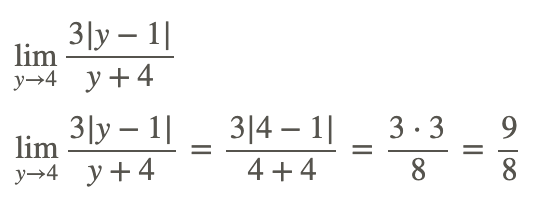1.5: Evaluate Limits Using Substitution
Finding limits for the vast majority of points for a given function is as simple as substituting the number that x approaches into the function. Since this turns evaluating limits into an algebra-level substitution, most questions involving limits focus on the cases where substituting does not work. How can you decide if substitution is an appropriate analytical tool for finding a limit?
Using Substitution to Find Limits
Finding a limit analytically means finding the limit using algebraic means. In order to evaluate many limits, you can substitute the value that x approaches into the function and evaluate the result. This works perfectly when there are no holes or asymptotes at that particular x value. You can be confident this method works as long as you don’t end up dividing by zero when you substitute. If the function f(x) has no holes or asymptote at x=a then:  Occasionally there will be a hole at x=a. The limit in this case is the height of the function if the hole did not exist. In other words, if the function is a rational expression with factors that can be canceled, cancel the term algebraically and then substitute into the resulting expression. If no factors can be canceled, it could be that the limit does not exist at that point due to asymptotes. Look at the following two limits:
Occasionally there will be a hole at x=a. The limit in this case is the height of the function if the hole did not exist. In other words, if the function is a rational expression with factors that can be canceled, cancel the term algebraically and then substitute into the resulting expression. If no factors can be canceled, it could be that the limit does not exist at that point due to asymptotes. Look at the following two limits:  The limit on the left cannot be evaluated by direct substitution because if 2 is substituted in, then you end up dividing by zero.The limit on the right can be evaluated using direct substitution because the hole exists at x=2 not x=3. Thus, the limit is:
The limit on the left cannot be evaluated by direct substitution because if 2 is substituted in, then you end up dividing by zero.The limit on the right can be evaluated using direct substitution because the hole exists at x=2 not x=3. Thus, the limit is: 
Examples
Example 1
Earlier, you were asked how to determine if you should use substitution to solve a limit. In order to decide whether substitution is an appropriate first step you can always just try it. You’ll know it won’t work if you end up trying to evaluate an expression with a denominator equal to zero. If this happens, go back and try to factor and cancel, and then try substituting again.
Example 2
Evaluate the following limit by canceling first and then using substitution. 

Example 3
Evaluate the following limit analytically: 

Example 4

Evaluate the following limit analytically.
Example 5

Evaluate the following limit analytically.
Review

Evaluate the following limits analytically.
Review (Answers)
To see the Review answers, open this PDF file and look for section 14.4.
Vocabulary
| Term | Definition |
|---|
| analytically | One way to evaluate a limit analytically is by substitution. Substitution is a method of determining limits where the value that x is approaching is substituted into the function and the result is evaluated. |
| Asymptotes | An asymptote is a line on the graph of a function representing a value toward which the function may approach, but does not reach (with certain exceptions). |
| Hole | A hole exists on the graph of a rational function at any input value that causes both the numerator and denominator of the function to be equal to zero. |
| limit | A limit is the value that the output of a function approaches as the input of the function approaches a given value. |
Additional Resources
Practice: Evaluate Limits Using Substitution Real World: The Limits of Tolerance
This page titled 1.5: Evaluate Limits Using Substitution is shared under a CK-12 license and was authored, remixed, and/or curated by CK-12 Foundation via source content that was edited to the style and standards of the LibreTexts platform.
LICENSED UNDER
- Back to top
- 1.4: Limits of Composite Functions
- 1.6: Properties of Limit
- Was this article helpful?
- Yes
- No

 Occasionally there will be a hole at x=a. The limit in this case is the height of the function if the hole did not exist. In other words, if the function is a rational expression with factors that can be canceled, cancel the term algebraically and then substitute into the resulting expression. If no factors can be canceled, it could be that the limit does not exist at that point due to asymptotes. Look at the following two limits:
Occasionally there will be a hole at x=a. The limit in this case is the height of the function if the hole did not exist. In other words, if the function is a rational expression with factors that can be canceled, cancel the term algebraically and then substitute into the resulting expression. If no factors can be canceled, it could be that the limit does not exist at that point due to asymptotes. Look at the following two limits:  The limit on the left cannot be evaluated by direct substitution because if 2 is substituted in, then you end up dividing by zero.The limit on the right can be evaluated using direct substitution because the hole exists at x=2 not x=3. Thus, the limit is:
The limit on the left cannot be evaluated by direct substitution because if 2 is substituted in, then you end up dividing by zero.The limit on the right can be evaluated using direct substitution because the hole exists at x=2 not x=3. Thus, the limit is: 






